I’m going to start with tennis, but if Wimbledon is not your cup of tea (get it), please feel free to skip to Jim Bouton and Tyler Skaggs for some pure baseball.
Breakfast at Wimbledon: Rita and I attended “Breakfast at Wimbledon” on Saturday and Sunday. Via ESPN.
We were also there thirty years ago. But that time at Centre Court. And closer to lunch time.
Founded in 1877, Wimbledon is the oldest tennis tournament in the world. The other three “Grand Slams” of tennis are the U. S. Open (1881), the French Open (1891) and the Australian Open (1905).
2019 Ladies’ Final (Saturday): Note: The championships at Wimbledon are played by “Ladies” and “Gentlemen.” There is no intent to change the terminology, i.e. modernize to “women” and “men.” Some say tradition. Some say snobbery. Whatever.
Serena Williams was again in a final at Wimbledon. She has won seven times, reflecting her dominance in women’s tennis this century. She won her first Grand Slam in 1999. In the 2000s, she won 10. In the 2010s, another 12. Total – 23. No other woman has won more than seven Grand Slams in that time period. To compare Serena to others, you have to reach back before 2000 for Steffi Graf (22), Chris Evert (18) and Martina Navratilova (18). The all-time champ, until Serena wins more, is Margaret Court with 24.
Serena’s opponent was Simona Halep of Romania. Halep was the number-one-ranked woman in 2017 and 2018, but she had won only one prior Grand Slam, the French Open in 2018. She now has two, easily beating Serena in straight sets (6-2, 6-2).
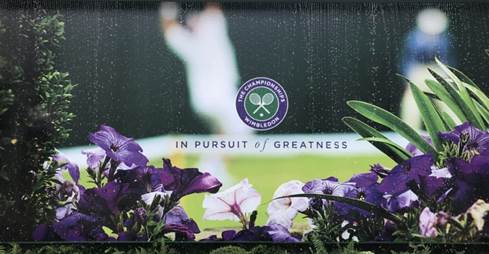
2019 Gentlemen’s Final (Sunday): Men’s tennis is dominated by three players: Roger Federer (age 37), Rafael Nadal (33) and Novak Djokovic (32). Entering Sunday’s final, the three (i) had won 52 of the last 62 Grand Slam tournaments (going back to 2004), and (ii) held the top spots in men’s career Grand Slams: Federer (20), Nadal (18) and Djokovic (15).
Déjà vu. All three were in the Wimbledon semi-finals. Djokovic beat Bautista Agut. Federer beat Nadal.
For the finals on Sunday, Rita and I settled in for breakfast. Pot of coffee. New York Times spread out on the table. DVR set to record CBS Sunday Morning. And then we watched Roger Federer and Novak Djokovic play. For the next four hours and 57 minutes.
Djokovic finally won to increase his Grand Slam total to 16. It was the longest final in Wimbledon history, edging out Federer’s loss to Nadal in 2008 (4:48). It would have been even longer if a new tiebreak system had not been put in place for 2019.
For an excellent recap of the match, I recommend this Joe Posnanski piece. I liked the way Joe summarized how Federer scored like the winner, but still lost:
“When Sunday’s heart-wrenching match ended, someone asked Roger Federer if he felt like he had been the better player. Fed won more games Sunday. He won 14 more points. He had more chances to win, including two championship points when he was serving in the fifth set. Tennis’ scoring system is a bit like the electoral college; winning the popular vote doesn’t mean winning the presidency.”
Now let’s go back 30 years for a very different Wimbledon.
1989 – London Vacation: In July of 1989, Rita and I went to London for a typical tourist experience. We did the museums, the Tower of London, changing of the guard, etc. We saw the hottest show in London’s West End, Phantom of the Opera. It was sold out, but we negotiated with a scalper (a “tout” in London) for tickets. We were several pounds apart on price when I suggested we flip for it. He agreed and we won the lower price.
When we planned our trip, we did not realize that it overlapped with the Wimbledon tennis championship. We heard the buzz while we were there and decided to take the short train ride to Wimbledon on Sunday. We did not have tickets, but hoped to score some, and if not, we would still get a feel for the event. On our walk from the train station to the courts, a tout sold us tickets for what seemed like a reasonable price. I think we knew that they were only standing room, but the memory is foggy. Whatever, we were going to be in the room where it happened. And if you are in that room, you must have the signature Wimbledon treat, strawberries and cream.
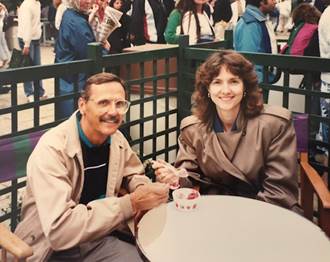
Sometimes You Get Lucky: There is a lot of rain in London, and it is not always good news. But it was for us on this Sunday. The women’s (err…ladies’) final had been rained out on Saturday, so both the women and men would be playing on Sunday.
And that was not the only luck. The “standing area” tickets turned out to be almost courtside. In those days, there were two standing areas, one on each side of Centre Court, located directly behind the first six rows of the lower stands. We were closer to the court than those in the Royal box. I later learned in a Sports Illustrated article that 1989 was the last year that these courtside standing areas existed. New fire regulations said it was too dangerous and the area was converted to seats.
The Sports Illustrated article included a colorful (and accurate) description of what we experienced:
“Standing room…was actually a pair of concrete holding pens …six rows back from the lush green lawn…Standees needed only a daily pass to enter and peer over shoulders and under armpits for as long as their rations held out…once you’re in and the canteen goes dry, no one drinks. Or eats. Or visits the bathroom, for that matter…[you don’t leave the area] unless you want to queue up again in a line that runs halfway to Big Ben.”
Rita and I stood in the second or third row and did not leave our spot until both finals had been played. We were younger then.
The “Programme”: Hard to believe, but I can’t find my ticket stubs. I do still have the 110-page “programme” – the English (as in England) spelling will be used here.
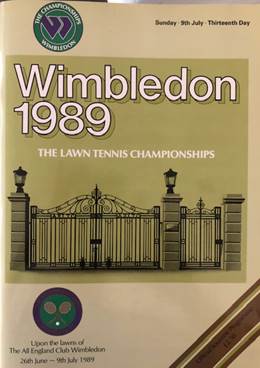
As I leafed through my old programme, some names caught my eye in the list of prior finalists. As shown in the clip below, Miss C. M. Evert was in four finals from 1973 to 1978. And then C(hris) disappeared. Not really. She got married to tennis player John Lloyd. For Wimbledon, she was now Mrs. J. M. Lloyd who played in the finals six more times. But she was still Chrissie to her fans. And how about that Mrs. L. W. King? That would be Billy Jean who married Larry. I’m guessing that the 2019 programme does not work this way (Would they really list Serena as Mrs. A. K. Ohanian?).
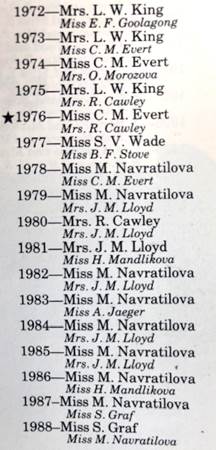
1989 Ladies’ Final (Sunday): The triumvirate of Chris Evert, Martina Navratilova and Steffi Graf were all there. They had won 12 of the last 15 finals at Wimbledon. Chris was winding down her career and would retire after the 1989 U. S. Open. She lost in the quarterfinals at Wimbledon and then joined the broadcast booth for the semifinals and finals – a precursor to her broadcasting career. Another player of note was 15-year-old Monica Seles, playing in her first Wimbledon. She made it to the round of 16 before being eliminated by Steffi Graf.
Martina and Steffi fought it out in the final. Below, our fuzzy photo of them taken with an old-style film camera. Graf won 6-1, 6-7, 6-1. It took one hour and 32 minutes. Rita and I held our standing positions, awaiting the men’s final.
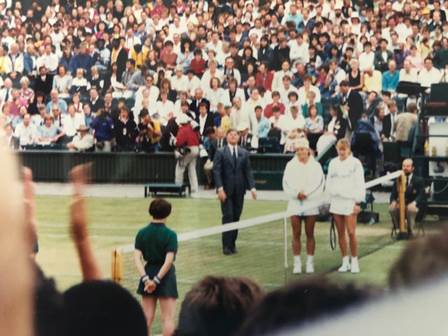
1989 Gentlemen’s Final (Still Sunday): We saw a rematch of the players from the 1988 final when Stefan Edberg defeated Boris Becker. The result was reversed for 1989 as Becker put Edberg away in straight sets (6-0, 7-6, 6-4).
As headlined in The Times of London: Germans sweep singles board at Wimbledon. Becker and Graf grew up in the same region of West Germany and knew each other from tournaments since childhood. As noticed by Rita yesterday, the hardware for the winners remains the same in 2019 – the man gets a trophy and the woman gets a dish.
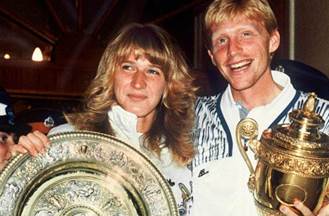
We Made It: As reported above, Rita and I never left our standing area during the matches. It did not hurt that the women finished in 1:32 and Becker dispatched Edberg in 2:12. Counting queuing up early, the break between the matches, and the awards ceremony, we were closing in on six hours at Centre Court. A saving factor was that it was cloudy almost the whole time. Don’t know if it would have worked in the sun. Or if it had been Federer and Djokovic.
There was one more highlight before we filed out. As reported in almost every news source, Boris Becker celebrated his victory by spinning around and throwing his racket into the stands. This is not the typical decorum at Wimbledon. Becker’s take: “You’re not in control of your emotions. I just let the racket go! I didn’t want to injure anyone, but everyone put their hands up and what a great souvenir to have the winning Wimbledon racket in ’89. The crowd was very much part of the match so it was a thank you note to say ‘this is for you as well’.”
Rita and I were among those who put their hands up to catch the racket. It came right toward us, but was snagged by a woman in the seats just in front of us. We have proof. This is the picture we took as she showed off her prize. If you look closely, you will see “Boris Becker”(upside down) on the rim.
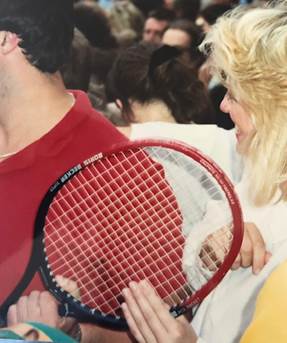
Wimbledon 1989 was an unexpected bonus for our London trip. Serendipity is good.
Now let’s get back to baseball.
Jim Bouton and Ball Four: Last week, Jim Bouton died. He was 80. Bouton played seven years for the Yankees, winning 21 games in 1963 and 18 in 1964. His Yankee career ended in 1968, but he caught on with the new expansion team in Seattle in 1969. He kept a diary of that season and converted it into a book titled Ball Four. When it was published in 1970, the s**t hit the fan.

Bouton’s book revealed the everyday off-the-field life of the players. Carousing, drinking, pill-popping, etc. The good sides too: sensitivity, vulnerability, curiosity. It showed that the players were human, not a bunch of vanilla heroes. He also reached back into his Yankees days, most notably with anecdotes about Mickey Mantle. The book was also hilarious and well written.
Many players and sportswriters were deeply offended. Bouton had violated the omerta of the locker room. Influential sportswriter Dick Young decreed that Bouton was a “social leper.” Commissioner Bowie Kuhn prodded Bouton to recant and admit that he made it up. Bouton declined.
Others appreciated the book. David Halberstam thought it was “the best sports book in years.” Baseball writing legend Roger Angell found it to be “a rare view of a highly complex public profession seen from the innermost side…and very likely the funniest book of the year.”
The controversy stirred up by Dick Young, Bowie Kuhn and others sold a lot of books. As Bouton said, “It was the perfect form of censorship. The publisher had only printed 5,000 copies on the grounds that nobody would want to read a book about the Seattle Pilots written by a washed-up knuckleball pitcher. Then the Commissioner calls me in and they have to print another 5,000 and then 50,000 and then 500,000.” Counting anniversary editions, millions of copies have been sold. Bouton was so appreciative of Young and Kuhn that he dedicated his next book to them (published in 1971, I’m Glad You Didn’t Take It Personally).
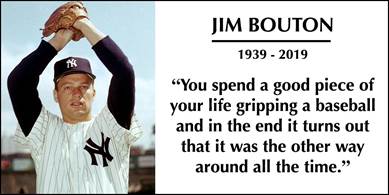
Over the years, the criticism by the establishment faded. After decades of shunning Bouton, the Yankees finally invited him back for old-timers’ day. Mickey Mantle forgave him. To this day, Ball Four shows up on lists of the most influential books. As a literary breakthrough, Ball Four led the way for a new type of journalism, not just in sports, but in entertainment, politics and other fields. The biggest impact was probably on sportswriters, many of whom wrote glowing tributes this past week (some examples: Jay Jaffe, Tyler Kepner and Charlie Pierce).
“There is Crying in Baseball”: I borrowed that line from Joe Posnanski’s article on Tyler Skaggs, the 27-year-old Angels pitcher who died earlier this month. Last Friday night, all of the Angels wore Skaggs’ #45. His mother, a softball coach, threw out the first pitch. These were noteworthy, but it was two other events that night that lit up social media.
Angels pitchers Taylor Cole and Felix Pena, both wearing #45, combined to pitch a no-hitter. The last time pitchers combined for a no-hitter in California was when Baltimore no-hit the A’s on July 13, 1991, the day Tyler Skaggs was born.
After the Angels completed their 13-0 victory, the players gathered in the infield and took off their jerseys to display on the mound. It may be the most moving scene on a baseball field since Lou Gehrig gave his Yankee Stadium speech in 1939. Click here for the video. Please watch. Manager Jimmy Dugan (Tom Hanks) in A League of Their Own was wrong. There is crying in baseball.
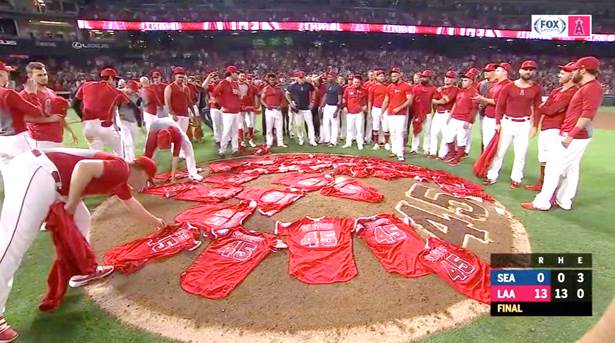
New on the Website: A new travelogue has been added to the Lonnie’s Jukebox website. Rita and I traveled to Petra in 2009, completing our quest to see the New Seven Wonders of the World. Most know Petra as the place where Indiana Jones (Harrison Ford) and his father (Sean Connery) went on their “Last Crusade” in search of the Holy Grail. Check out this clip from the 1989 movie to see the actors on horseback at the Treasury of Petra. Then click here to see us at the same place 20 years later (sans horses).
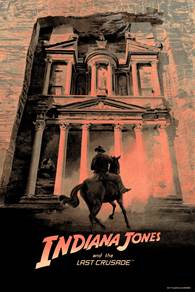
Lonnie’s Jukebox – Dave Bartholomew: Last month, Dave Bartholomew died at age 100 (NYT obit here). His name and profession have been well known to me since I was a teenager. Let me explain.
When I was 13, I started buying records of the new rock ‘n’ roll sound. Already exhibiting some of my obsessive behavior, I paid attention the whole record label. One interesting thing to this music neophyte was the parenthetical below the song title that identified the writer(s) of the music. So when I saw “(R. Penniman)” below “Tutti Frutti” by Little Richard, I found that this was Richard Penniman, known by his stage name of, you guessed it, Little Richard. This is also how I first learned that Buddy Holly and Chuck Berry wrote many of their own hits. Not so with Elvis Presley who relied on writers like Jerry Leiber and Mike Stoller.
What about Fats Domino? On almost all of his records, the parenthetical showed “(A. Domino and D. Bartholomew).” I was not surprised to find that A. Domino was Fats (given name, Antoine). But who was the other writer?
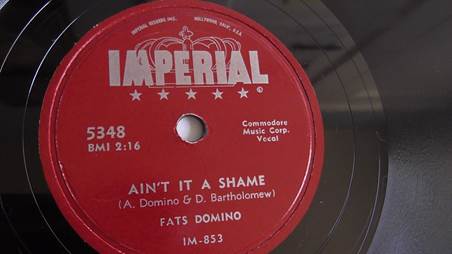
It turned out to be Dave Bartholomew, a New Orleans trumpeter and band leader who branched out to arrange, produce and compose with some of the biggest acts of R&B and rock ‘n’ roll. He is in the Rock and Roll Hall of Fame. His biggest collaboration was with the great Fats Domino. I wrote a lot about Dave when I did my tribute to Fats Domino after he died in 2017. That post also includes a playlist of many of their songs. Click here for Hot Stove #58 (“Fats Domino – RIP – Ain’t That a Shame”).
[Label Trivia: Black artists were rarely recorded by major labels in those days. This led to independent labels like Imperial. Another item on the label was the time of the recording (2:16). An anomaly in the pictured label is the song title “Ain’t It A Shame.” The song is actually “Ain’t That A Shame,” but the record company made a typo.]
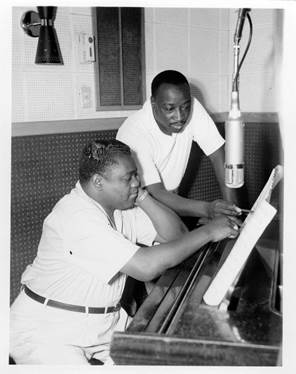
Above, Fats at the piano working with Dave. And now for some of their hits:
“Ain’t It (That) a Shame” – my first Fats’ record.
“Blueberry Hill” – Fats’ biggest hit and Irv Blond’s favorite. Not written by Dave or Fats. They reworked an old 1940 song that had been recorded by the likes of Gene Autry, Glenn Miller and Louis Armstrong. I’m guessing Fats’ version is the best.
“Blue Monday” – written solely by Dave while stranded in Kansas City by a snowstorm after a gig.
“I’m Walkin’” – will make you want to get up and dance.